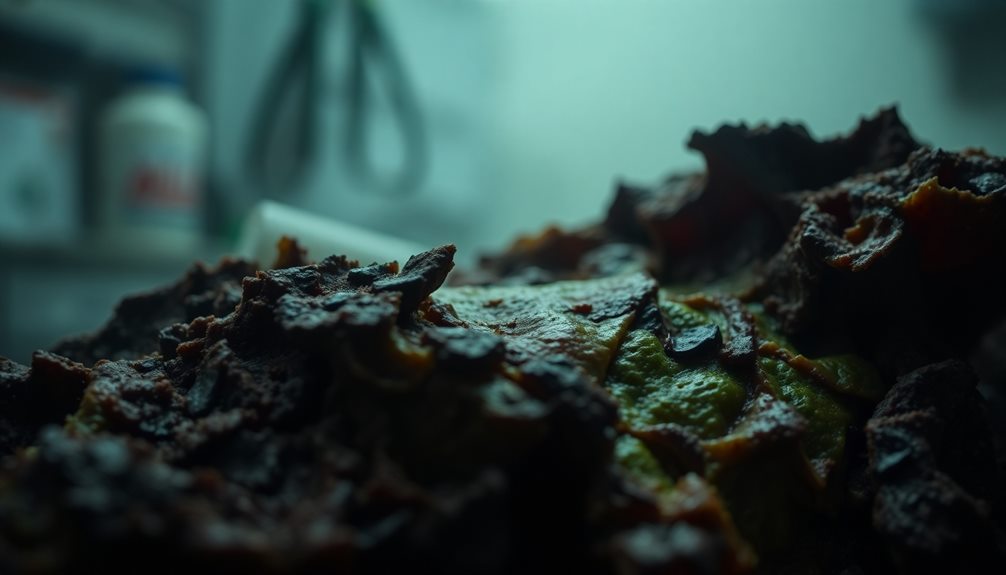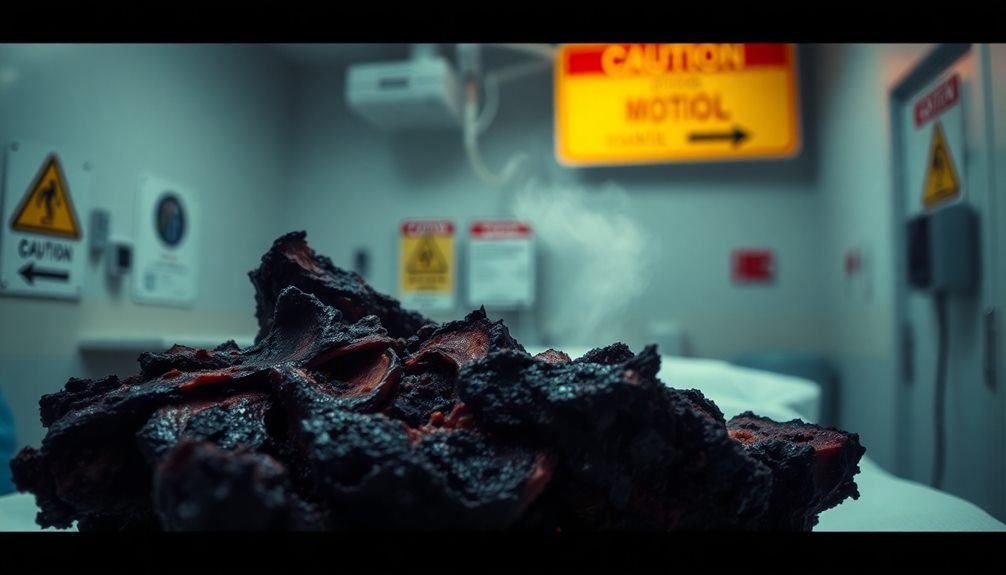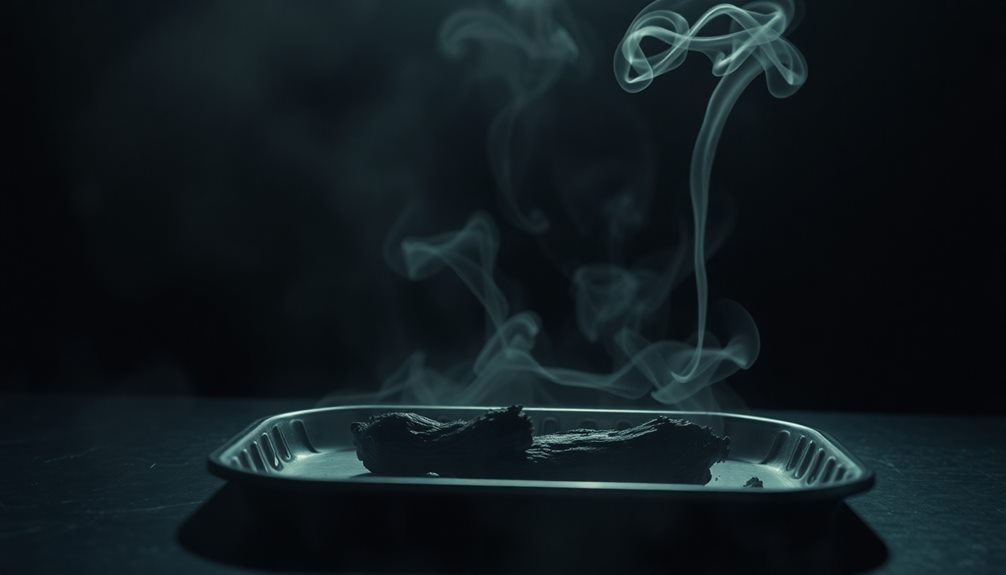Necrosis has a strong, putrid smell that you can't ignore. It often resembles rotting flesh, mixed with a sickly sweetness that can be pretty overwhelming. This distinct odor comes from broken-down cells and bacteria in dead tissue, releasing gases that evoke strong feelings of discomfort. You might notice this smell in places like hospitals, especially around serious wounds or infections. It's essential to recognize this scent as it warns you of potential health issues that need immediate attention. Understanding more about necrosis could help you recognize its signs and protect your health even better!
Key Takeaways
- Necrosis produces a strong, putrid odor resembling rotting flesh, often overwhelming and hard to ignore.
- The smell includes acrid notes and a sickly sweetness due to tissue breakdown.
- Gases like hydrogen sulfide and volatile fatty acids from decaying tissue contribute to the rancid scent.
- Bacterial decay in necrotic tissue releases foul-smelling compounds, intensifying the odor.
- Recognizing this smell is crucial for identifying serious health issues requiring immediate medical attention.
Introduction

When it comes to understanding necrosis, many people may not realize that it has a distinct smell. You might think of the word necrosis and picture something serious, and you'd be right! But there's more to it.
Necrosis happens when cells in your body die. This can occur due to injury, lack of blood flow, or infection. As these cells break down, they release substances that can create a noticeable odor.
You might wonder why the smell matters. Well, it can be a helpful clue for doctors. If you ever encounter this situation, knowing about the smell could help you identify something that needs immediate attention. It's like a warning signal!
Understanding necrosis and its effects can also empower you to take better care of your health.
Description of the Smell

A strong, putrid odor often accompanies necrosis, reminiscent of rotting flesh or decaying organic matter. When you encounter this smell, it can be overwhelming and hard to ignore. You might notice an acrid, sickly sweetness that mixes with the pungent scent, creating an unsettling aroma that fills the air.
It's not just unpleasant; it's a smell that can linger in your memory long after the source is gone.
Imagine being in a warm, moist environment where decay thrives. The air feels heavy, and the smell wraps around you, almost like a thick fog. It may remind you of a forgotten piece of fruit left in the sun or a wet dog that hasn't had a bath in a while. Your senses might tingle, and you could feel a shiver run down your spine.
This odor can evoke strong reactions, making you want to step back and cover your nose. Understanding this smell is important, especially in health settings, as it can signal serious conditions.
Source and Composition

The putrid odor of necrosis stems from the breakdown of tissues and the decay of organic matter. When cells in your body die, they release proteins and enzymes that break down. This process creates gases like hydrogen sulfide and ammonia, which contribute to that awful smell you might associate with rotting flesh.
Imagine walking past a dumpster on a hot day; that's similar to what necrosis can smell like!
The composition of this odor is complex. You've got volatile fatty acids, which are produced as fat breaks down. These acids can create a rancid scent that sticks to your nose.
Additionally, bacteria play a significant role—they feast on dead tissue, releasing even more foul-smelling compounds.
As necrotic tissue becomes infested with bacteria, it turns into a breeding ground for odors. You might think of it like a science experiment gone wrong, where the combination of elements creates a very unpleasant result.
Understanding the source and composition of necrosis can help you visualize why it smells the way it does. Next time you encounter this odor, you'll know it's a mix of decay, bacteria, and gases all coming together to create that unmistakable scent!
Typical Scenarios or Environments

Necrosis can occur in various environments, often where tissue damage is present, such as in wounds, infections, or severe injuries. You might find this happening in places like hospitals, where patients with deep cuts or surgical wounds are treated. In these situations, the body's tissues can die due to a lack of blood flow or infection.
Imagine a person with a serious burn. The damaged skin can start to rot, creating a pungent smell that's hard to forget. You might also encounter necrosis in diabetic patients, where sores on their feet can become infected. These wounds can produce a strong, unpleasant odor, signaling that something's gone wrong.
Another common scenario is in cases of gangrene, which occurs when blood flow to a certain area stops, often due to an injury or infection. The dead tissue can emit a foul scent, warning you that immediate medical attention is needed.
Understanding these typical environments helps you recognize the signs of necrosis, allowing for quicker action and better outcomes. So, if you ever encounter these situations, remember that the smell can be a crucial indicator of an underlying problem!
Emotional or Cultural Associations

When you think about necrosis, it might evoke strong emotional reactions or cultural associations tied to death and decay. This can be unsettling, as our minds often connect necrosis with images of rotting flesh or dying plants. These associations can make you feel uneasy, even if you're just curious about the topic.
In many cultures, decay symbolizes the cycle of life, where death leads to new beginnings. You might remember stories or movies where characters confront decay, urging them to appreciate life's fragility. This connection can spark a sense of urgency in how you live your life, reminding you that everything eventually changes.
On the other hand, necrosis can also bring feelings of fear or disgust. Some people might recall experiences with illness or injury, making the subject even more personal.
It's fascinating how something as scientific as necrosis can stir such deep emotions and cultural reflections.
Health or Safety Considerations

Understanding the health implications of necrosis can help you recognize its potential dangers. When tissue in your body dies, it can lead to serious health issues. If you notice unusual smells or discoloration, don't ignore them! These signs might indicate necrosis, and it's essential to act quickly.
In some cases, necrosis can lead to infections. When dead tissue is present, bacteria can thrive, putting your body at risk. You might feel pain, swelling, or experience fever, which are all signs that something's not right. If you notice these symptoms, it's vital to seek medical attention immediately.
Also, be cautious if you're caring for someone with necrosis. Proper hygiene is crucial, as you don't want to spread any potential infection. Wearing gloves while handling affected areas can protect both you and the person you're caring for.
Always remember, staying informed and alert can save lives. By recognizing the signs and symptoms of necrosis, you can take the necessary steps to ensure your health and safety.
Final Thoughts

Recognizing the signs of necrosis is crucial for your health and safety. When you notice a foul smell, discoloration, or unusual warmth in a wound, it's time to take action.
Understanding what necrosis smells like can help you identify it early, which might prevent more serious health issues. Remember, the odor often has a strong, putrid quality, and it can be a sign that tissue is dying.
If you or someone you know experiences these symptoms, don't hesitate to consult a healthcare professional. Quick action can make a world of difference!
It's also wise to keep an eye on any ongoing health conditions that might increase the risk of necrosis.
Stay informed and take charge of your health. You deserve to heal quickly and fully, so be proactive about your well-being.
Frequently Asked Questions
Can Necrosis Smell Different in Various Body Parts?
Yes, necrosis can smell different depending on the body part. Factors like the type of tissue, presence of bacteria, and surrounding environment influence the odor. You may notice variations in smell based on these conditions.
How Does Necrosis Impact Surrounding Tissues' Smell?
When necrosis occurs, it disrupts surrounding tissues, leading to changes in their smell. You might notice a distinct, unpleasant odor as the affected area decays, signaling tissue breakdown and the presence of bacteria or infection.
Is Necrosis Smell Detectable in Early Stages?
In the early stages, you might not detect necrosis smell easily. As the condition progresses, however, the scent becomes more pronounced. It's crucial to monitor any unusual odors in affected areas for timely intervention.
Are There Any Home Remedies to Mask Necrosis Odor?
You can try using essential oils like lavender or tea tree to mask unpleasant odors. Activated charcoal or baking soda can also help absorb smells. Remember, though, addressing the underlying issue is crucial for lasting relief.
Does Diet Affect the Smell of Necrosis?
Your diet can influence body odor, including any odors related to necrosis. Foods rich in sulfur or certain spices might intensify unpleasant smells. Staying hydrated and eating a balanced diet can help manage overall body scent.









